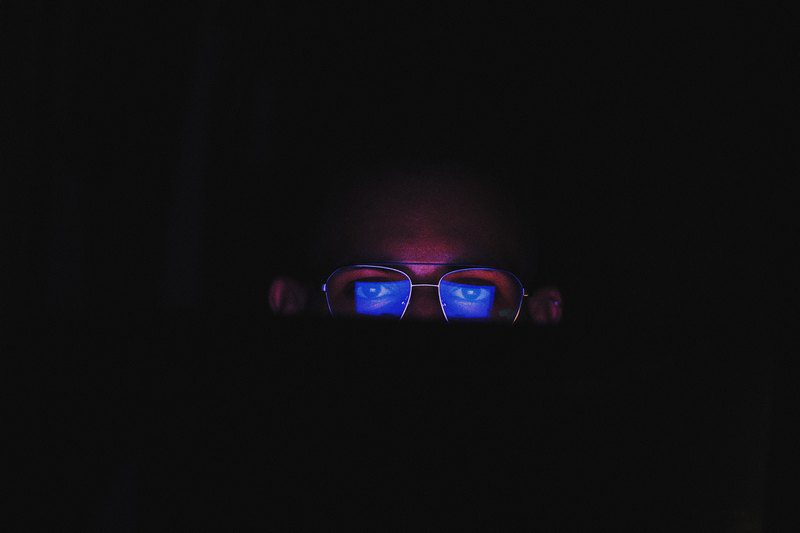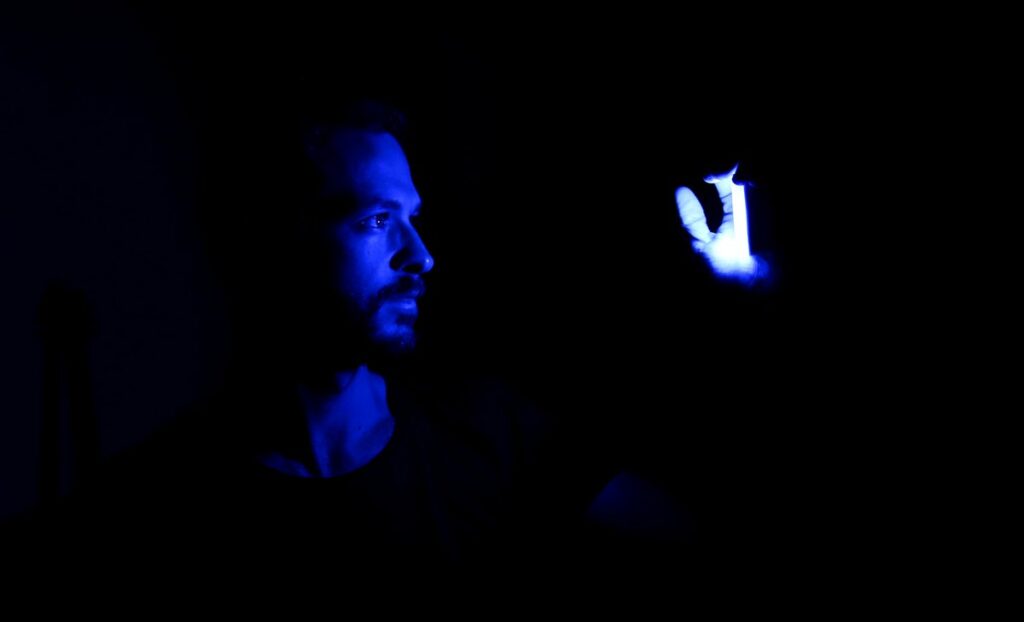Post Contents
What is Blue Light?
Any visible light is made up of a wide spectrum of colours, even if they aren’t visible to the naked eye. White light – the kind of light emitted by the sun or a common light bulb – is made up of ROYGBIV: red, orange, yellow, green, blue, indigo and violet light. Each of the colours of light has a different wavelength and carries a different amount of energy.
Red light, at the top of the spectrum, has a long wavelength and is low energy, whereas blue light (blue light covers the blue, indigo and violet spectrum), much further along the spectrum has far more energy and a short wavelength. The short wavelengths towards the blue end of the spectrum include UV radiation and x-rays. The shorter the wavelength of light, the more it can penetrate objects or cause damage to cells in the human body.
Blue light is also referred to as High Energy Visible (HEV) light. Light wavelengths are measured in units of one billionth of a metre, referred to as nanometres (nm). Visible red light is measured around 700nm, whereas blue light is measured around 400-500nm.
Sources of Blue Light
While the sun is the most powerful source of blue light, it is not the only source. Far from it in fact; sources of blue light in the household include fluorescent lights, LED flights, LED screens and TVs, computer monitors, mobile devices (phones and tablets) and more.
With more people than ever working from home, exposure to blue light emitted from digital devices is near constant, with little in the way of breaks from commuting, sitting in meetings or going out to lunch. For many of us, heading out to lunch is something that is not possible, and meetings are conducted over Zoom, Skype or another video conference solution that keeps you glued to your desk, staring at a screen.
While the amount of blue light emitted by digital devices and artificial lighting is miniscule in comparison to that emitted by the sun, there is concern that both proximity to digital devices and the amount of time spent in front of them may be harmful. As yet there has been no substantial and legitimate scientific study into the topic of digitally emitted blue light
What Does Blue Light Do?
Exposure to blue light doesn’t have to be detrimental. Limited exposure to short wavelength light has actually been shown not only to be good for you but to be essential for maintaining good health. Research shows that blue light exposure may help moderate mood and increase energy levels, cognition and alertness. Blue light therapy is also used to treat some forms of Seasonal Affective Disorder (SAD), a form of depression that ebbs and flows with the seasons and is most often triggered by winter.
In addition to helping to regulate mood, blue light is also essential when it comes to your circadian rhythm – the natural sleep/wake cycle. In the absence of technology, blue light exposure from the sun during the day helps maintain a healthy circadian rhythm. Unfortunately, due to the abundance of blue light emitting technology in the average home, people now have exposure during the night as well.

Excessive exposure to blue light at night such as watching TV or using a tablet or phone in bed has been linked to difficulty sleeping, as exposure blocks the production of melatonin, a hormone your brain produces in response to darkness, helping trigger the sleep cycle.
What Can Blue Light Do To Your Eyes?
Despite the number of benefits blue light can have for your body, it may also have a negative effect on your eyes. Your eyes are naturally very good at filtering UV radiation, but are poor at filtering visible blue light. This means that blue light is able to pass through the cornea (the clear outer layer at the front of the eye) and lens (the part of the eye that enables you to focus) to enter the back of the eye, the retina.
Although more research is needed, studies have shown that blue light may be capable of causing damage to the retina. This blue light damage is highly comparable to the damage caused by AMD – Age-Related Macular Degeneration, the number one cause of vision loss in Australia and hugely prevalent across the world.
A 2014 meta analysis of population based AMD studies taken around the world shows that around 8.7% of the global population suffers from AMD.
Due to the intensity of the light, exposure to blue light from the sun is the leading cause of blue light damage to the retina. Although the research into the link between digital blue light and retinal damage is still inconclusive, digital blue light has also been linked to digital eye strain due to the way the short frequency light scatters.
While all wavelengths of light can scatter, short wavelength light scatters easily, leading to what is referred to as visual noise. Essentially, this scattered light makes it harder for your eyes to focus. It is believed that this scattered light and visual noise may be responsible for Digital Eye Strain.
It is thought that in addition to blue light scattering and visual noise, proximity to a screen and extended periods of time focussing on a single focal length are the cause of digital eye strain. For this reason, the condition is also sometimes referred to as Computer Vision Syndrome.
How To Protect Yourself From Blue Light
As the sun is the largest emitter of blue light, protecting your eyes from the sun is your number one priority. Wearing sunglasses that block nealy all UV light are good, but sunglasses that fully cover your range of vision – known as full coverage sunglasses are better. The higher the UV protective rating of sunglasses the better, with glasses rated UV 400 capable of blocking all blue light up to 400nm.
If you wear prescription glasses there are a number of options to help protect your eyes from blue light damage. In addition to prescription sunglasses and transition lenses, many optometrist also offer blue light filtering lenses that can be used in place of your regular lenses.

Blue light protectors, such as glasses or screen filters rated up to 450nm may help reduce instances of digital eye strain or damage caused by blue light exposure. These protectors may also help improve screen contrast by reducing light scatter and visual noise.
There are also a number of apps and programs available for PC, Mac and mobile platforms to reduce the amount of blue light emitted by a screen, including Twilight: Blue Light Filter for Android, Night Shift for iOS and MacOS, or F.LUX for Windows, MacOS and Linux. These apps can help reduce the amount of blue light emitted by your devices, but refraining from using mobile devices (phones and tablets) in the hours preceding sleep may better help maintain a healthy circadian rhythm.
Taking regular breaks from your screen is essential for minimising eye strain and may also help reduce the risk of Dry Eyes, a condition that may be caused in part by improper or irregular blinking, causing the tears that protect our eyes from the environment to not be fully replenished. There are a number of programs available on both PC and Mac that blacken or otherwise remind you to take a break at regular intervals.
The bottom line…
You only have one set of eyes, and while eye damage caused by blue light exposure, AMD or other degenerative conditions can be mitigated or slowed, it can’t be repaired. When it comes to your eyes protection is the name of the game.






